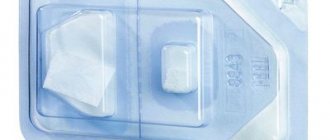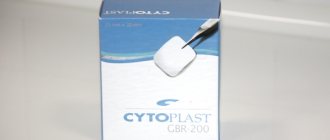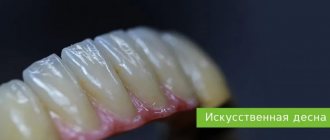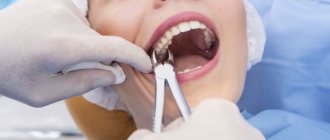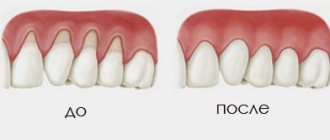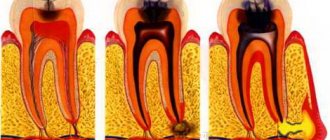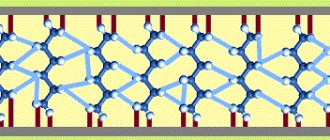Implantation, the most successful and effective method of restoring a natural smile, is constantly being improved, as is dental treatment in general. Patients are offered innovative techniques that provide better results or reduce the duration and cost of treatment. One of the major achievements in recent years has been the barrier membrane, which is installed in conditions of bone tissue deficiency.
Alveolar ridge atrophy is almost inevitable in people who require implantation. Some people delay therapy for a long time, which is why the bone has time to dissolve, while others have congenital structural features of the jaw apparatus. In any case, performing dental implantation in the event of atrophic phenomena in the bone tissue becomes impossible. Such an error threatens the following adverse consequences:
- Loosening, retraction or even loss of the implant (sometimes its loss is quite traumatic, involving the patient’s bone tissue);
- Impossibility of performing bone grafting in the future due to excessive thinning of the bone (any intervention risks fractures).
Moreover, jaw bone resorption is so seriously detrimental to the patient that even without implantation, bone grafting remains a necessary surgical procedure.
Gradually progressive atrophy leads to the fact that the face becomes asymmetrical and ugly: wrinkles worsen, the functioning of facial muscles is disrupted, and so on. The chewing function of the jaws is significantly affected, which is why patients eat poorly and have problems with the gastrointestinal tract. In advanced situations, speech and swallowing are noticeably impaired, and breathing movements are less likely to suffer. Therefore, bone grafting with additional installation of a barrier membrane must be performed immediately after the problem is detected.
In what cases are barrier and protective membranes applied?
Membrane linings perform several functions:
- Protective - protect the operated area from external factors.
- The role of the reinforcing material is to fix the osteoplastic material in a suitable position.
Applicable:
- when strengthening mobile units;
- to protect bone from atrophy after tooth extraction;
- when it is necessary to fix granules of osteoplastic material during osteoplasty before or during implantation;
- when building up the jaw bone with blocks.
The decision to use barrier membranes is made by the dentist after a preliminary examination.
To increase bone
An osteoplastic material is fixed under the gum, on top of which a protective pad is placed. It protects the bed and its contents from growing soft tissues. Eliminates washing out of the bone graft from the wound through the suture line. More reliable treatment results are provided by the use of a bone substitute along with two types of membranes. One of them covers the defect and osteoplastic material, and a collagen plate is placed on top of it.
Gum extension (augmentation) during gum recession
Deficiency of soft tissues as a result of atrophy is characteristic of patients with long-term absence of teeth. Significant bone loss in such cases is accompanied by a proportional decrease in gum volume, which causes significant discomfort. Augmentation is more expensive and more difficult to install an implant. Gum augmentation can be performed with non-resorbable membranes, usually based on a non-porous material and resorbable, with a high rate of tissue compatibility. The method promotes rapid healing, reduces the risk of relapse and soft tissue swelling.
Indications and contraindications for the use of plasma lifting
Indications:
- increasing the rate of tissue healing during sinus surgery and bone addition;
- recession plastic;
- treatment of periodontal diseases;
- activation of growth factors in bone cells after tooth extraction;
- implantation simultaneously with the introduction of bone material;
- various surgical interventions.
Contraindications:
- malignant neoplasms;
- systemic diseases of the blood system that do not allow plasma to be isolated or used effectively;
- decreased immunity;
- diseases in the acute stage;
- taking antibiotics;
- mental illness.
Types of biomaterials used
The method of directed tissue regeneration in surgical dentistry is based on the use of two main groups of membranes: resorbable (collagen, vicryl, polylactic acid, etc.) and non-resorbable (Gore-tex or titanium mesh, with titanium reinforcement, Teflon and others).
Resorbable
Installation of absorbable membranes prevents their removal after the osteoplastic material has engrafted. Such linings do not always remain stable over a long period. To enhance the prolonged action, their composition is supplemented with slowly resorbing substances. One of the main advantages of membrane linings is the possibility of enriching their structure with drugs that enhance osteogenesis, anti-inflammatory, antimicrobial agents, etc.
Types of resorbable membranes:
- Synthetic polymers (polyactides, polyglycolides) and their chemical modifications (for example, Guidor, EpiGuide, Vicryl) - decomposition into microscopic fragments that undergo phagocytosis occurs under the influence of hydrolysis. Among the disadvantages of the products, weak tissue integration and a high likelihood of developing swelling during resorption due to changes in pH in the tissues are noted. Advantages of polymer plates:
- no risk of transmitting an infectious disease;
- hypoallergenic;
- long-term effect (5-6 months).
Non-resorbable
They contribute to the effective restoration of bone in a given volume and trajectory, there are:
- Frameless - for restoration of bone tissue less than 4 mm.
- With a titanium frame - for bone restoration in large volumes, in all directions.
Main advantages:
- high mechanical strength;
- pronounced barrier properties.
These types of pads should be removed after 6-9 months . Consisting of titanium, they are effective in situations where there is a large load on the bone and it is necessary to protect implants or osteoplastic material. The most common indication for use is vertical ridge augmentation. They are removed after restoration of soft and bone tissues damaged during the operation.
Main disadvantages:
- risk of exposure - during suturing of the flap, the insert must be completely closed;
- absence of the process of periosteum formation under the overlay;
- the patient needs to visit the dentist frequently (every 2 weeks).
Statistics show that the most effective membranes are polytetrafluoroethylene (PTFE) GoreTex and aliphatic polyetherurethane (Bone-up). Less commonly used are mesh forms made of calcium sulfate (Capset) or titanium (Frios, BoneShield, Tiomesh).
Pros and cons of absorbable membranes
Resorbable membranes have many advantages. One of the main ones is resorption. Biodegradable pads do not need to be removed; they disappear on their own after a few months. Additional surgery to remove them is not required, which speeds up recovery after osteoplasty.
The advantages of such overlays also include:
- ease of installation,
- good barrier properties,
- low risk of soft tissue swelling,
- affordable price.
Resorbable membranes are used to restore small areas of the jaw bone. They are not suitable for building large volumes of bone tissue.
Fixing elements of different types
The membrane is adjusted to the size of the defect, or the required dimensions are transferred to it using sterile templates in the package. The edges should overlap the boundaries of the bone defect by at least 2-3 mm . Fixation can occur in one of several ways:
- Before installation, the resorbable pad is pierced and placed on the implant using the rubber dam principle. The edges are secured with screws or pins into the bone, in which holes are previously created with burs. Additionally secured with sutures to the periosteum. When used on the upper jaw, titanium pins with a wide head are used for fastening.
- The self-curing mixture or film with an adhesive composition is fixed directly to the alveolar process.
- Non-resorbable plates are fixed with titanium pins or microscrews. The edges of the barrier must be tightly adjacent to the bone to prevent soft tissue ingrowth. When suturing the mucosa, small diameter suture material is used. The thread should pass along the edge of the membrane in contact with the neck of the implant. The stitching is done in the middle of the overlay between the edge stitches.
Opinion of a dentist-implantologist : “The success of implantation depends on how accurately patients follow medical recommendations. The operated area should be protected from hard, hot foods. Hygiene must be regular. Medications are taken only in consultation with a doctor.”
- Complete restoration of the dentition in just 4 days!
more detailsRoott Pterygoid Implants Sinus lift is no longer needed!
more details
Once and for life! Express implantation in 4 days with a permanent ReSmile prosthesis
more details
All-on-4, All-on-6, ReSmile, Zygomatic implantation We use all modern methods of dentition restoration
more details
Qualities of a good membrane
A good, reliable membrane has the following qualities:
- biocompatibility with tissues of the human body,
- 100% control of tissue proliferation,
- perfect integration,
- preserving space for alveolar bone,
- ease of use.
Depending on these properties, which, in turn, largely depend on the material of manufacture, the dental membrane guarantees a successful result of any surgical operation. Therefore, before choosing the ideal membrane, let's talk about the types of dental membranes that exist in dental practice today.
How membranes take root during dental implantation
Collagen membrane overlays reduce the risk of complications due to loss of soft tissue. Non-stitched - due to the healing of soft tissues by secondary intention, the wounds are protected from the general inflammatory process. Both types integrate well into the jaw tissue. The bone under the surface of the barrier plate is regenerated in a manner similar to fetal bone growth.
When using absorbable overlays, the postoperative wound heals without the use of additional medications. Often the healing process of non-resorbable membranes is accompanied by complications, in particular, exposure of the structure. This can lead to infection and inflammation, which means it will have to be removed prematurely.
Often, under the barriers a favorable background is created for the development of microbes, so it is not always possible to achieve the desired result.
Technology and preparation features
Preparation for the procedure does not have any specific features. The most important thing is to exclude fatty and spicy foods and alcohol the day before. It is also advisable to get a good night's sleep. Blood sampling is not carried out while taking antibacterial drugs - you must wait until the end of therapy.
The procedure takes a little time and is carried out as follows:
- blood is drawn from a vein directly in the clinic,
- The tubes are placed in a centrifuge. Isolation of fractions takes from 10-15 minutes to half an hour or even 40 minutes (depending on the patient, since the platelet sedimentation rate is different for each person),
- Thick plasma is taken from a test tube - such a membrane can be cut, sutured, and used in various techniques. It is placed in the required quantity during surgical operations.
Ready-made membranes are stored for a maximum of 4 hours, so blood sampling and processing are carried out directly on the day of installation of implants or other surgical interventions.
Disadvantages of the technique
The technique has no disadvantages. The only thing that can be highlighted is the increase in cost. However, membranes are very effective, making the surgical process more comfortable for the patient and reducing the risks of postoperative complications. And in some situations, the use of this technology is even cheaper than classical bone grafting.
When performing bone grafting using membranes obtained from blood plasma, the Smile-at-Once clinic also uses special growth activators (PrefGel and Emdogein from Straumann), which clean the cavity and additionally stimulate the growth of bone and gum tissue, which is necessary for accelerating the healing process of implants, especially when using one-stage implantation methods with immediate loading.
1 Tolstov D.A., Bogdan V.G. Platelet concentrates: classification, production technologies, biological effects, 2012.
Membrane exposure after bone grafting - consequences and treatment
The non-resorbable membrane pad is exposed in 1% of cases , causing the following consequences:
- wound infection with the development of purulent inflammation;
- rejection of osteoplastic material during vascularization of the mucous membrane (in 40-50% of cases).
In such situations, it is recommended to remove the implanted materials, carry out treatment, and then repeat bone grafting. Typically, a second layer of soft tissue is formed under the incision using a mucoperiosteal flap. To do this, it is peeled off, split, modeled, and then sutured in layers.
The exposed resorbable pad should be treated with 3% hydrogen peroxide and 0.12% chlorhexidine. Sometimes this allows you to postpone the removal procedure by 8 weeks.
Opinion of a dental surgeon : “Most of my patients are smokers. Many people do not immediately realize the complexity of the situation caused by their bad habit. Smoking causes a sharp narrowing of the blood vessels in the mouth. This weakens the flow of blood filled with oxygen and nutrients. Due to their lack, the healing process is delayed. Therefore, you need to completely stop smoking at least a couple of weeks before implantation and for several months after it.”
Periodontology
Most people dream of snow-white teeth and almost always forget about an essential component of a beautiful smile – pink, healthy gums. Many people consider gum problems to be an unpleasant little thing that does not require medical consultation or treatment. In recent years, much evidence has accumulated that gum disease leads to rheumatoid diseases, and the risk of myocardial infarction, stroke, gastritis and stomach ulcers increases. Among the most common diseases of the oral cavity are periodontitis.
and
periodontal disease.
Why does your dentist refer you to a periodontist?
If a dentist believes that your gums require special treatment and refers you to a periodontist, then he is taking exceptional care of your health.
Most people bravely endure bleeding gums, pain after eating, and a slight taste of blood in the mouth. Such symptoms occur periodically, and then the inflammation subsides. But this is only apparent well-being. IMPORTANT: Symptoms of periodontitis
different forms differ in the degree of severity and spread of the inflammatory process, as well as the reasons that caused it.
Who is a periodontist?
Only a specialist can understand all the nuances of diseases of the tissues surrounding the tooth (periodontium).
Which dentist in dentistry is best familiar with this problem, and who should you contact, a therapist or a surgeon, if there are signs of bleeding gums. There is an opinion among patients that a hygienist is a periodontist. This is a deep misconception.
A periodontist is a dentist who deals with the pathology of the tissues surrounding the tooth. Periodontics is a separate branch of dentistry.
Periodontist at Chistye Prudy
is a specialist who has full command of all
modern techniques aimed at stabilizing and improving the situation with periodontal tissues.
What does a periodontist treat? A periodontist is a doctor who specializes in the diagnosis, prevention and treatment of gum (periodontal) diseases. Assessing the color and density of the gums, tooth mobility, and the amount of lost bone tissue, the periodontist will discuss with the patient and propose the optimal treatment plan.
What methods of treating periodontitis are available to a periodontist?
In the early stages of gum disease, it is often enough to:
- closed curettage,
- laser application.
- smoothing the root surface using the Vector system.
In most cases, these manipulations are sufficient to achieve a satisfactory result. In later stages, surgical intervention may be required, which remains the leading option in complex treatment. It includes:
- open curettage technique
, - patchwork operations.
- gingivoplasty.
What tasks does a periodontist face?
- Elimination of inflammation - however, this is not the biggest
a problem faced by a periodontist! - Restore damaged bone tissue.
- Elimination of cosmetic defects of gums.
IMPORTANT
: Only a professional periodontologist can solve these problems, since periodontal surgery requires special precision, delicacy of execution and the ability to use the latest techniques.
Reviews.
Anzhelika Vardanyan
March 07, 2022 16:04
For 6 years, my family and I have been visiting the Dentist! Doctors greet you like family. Galina Alekseevna is a very experienced and competent dentist, she thoroughly examines the oral cavity and takes pictures of the teeth. He will always tell you what the problem is with a photo or diagnostic. Freed me from a serious gum problem. The clinic has the best impressions, the best doctors, total care for clients, you feel that you are valued! sokolttta
April 05, 2022 21:18
Completed the course of treatment at the Dastyst dentistry. I would like to express my gratitude to Galina Alekseevna and Valentina Vladimirovna! For treatment and prosthetics. I didn’t expect that my gums could be healed and veneers installed so quickly. I recommend this dentistry to those who need high-quality services in a short time...
Cost of admission.
Periodontist in Moscow is a sought-after specialty, since
Diseases of the tissues surrounding the tooth, in terms of prevalence, occupy the second position after caries. Prices for treatment depend not only on the qualifications of the specialist, on the level of equipment of the clinic with modern equipment, but also on the doctor’s ability to use modern techniques.
The use of laser equipment, “Vector Systems” in the treatment of gums, requires additional material costs, but is the most effective in difficult situations. This fully applies to patchwork operations that require high professional skills and knowledge from a specialist.
IMPORTANT:
Therefore, contacting a periodontist in the early stages of periodontitis will allow you to avoid expensive treatment and get a positive result in one visit.
In our clinic "Dentist" near the Chistye Prudy metro station, a unique information computer system "FloridaProub"
.
Moscow is a huge metropolis, so in order not to waste time searching for a center, you can sign up for a consultation at the Dentist clinic. In this case, your problem will be dealt with by one of the best periodontists in Moscow, who thoroughly knows all modern techniques.
